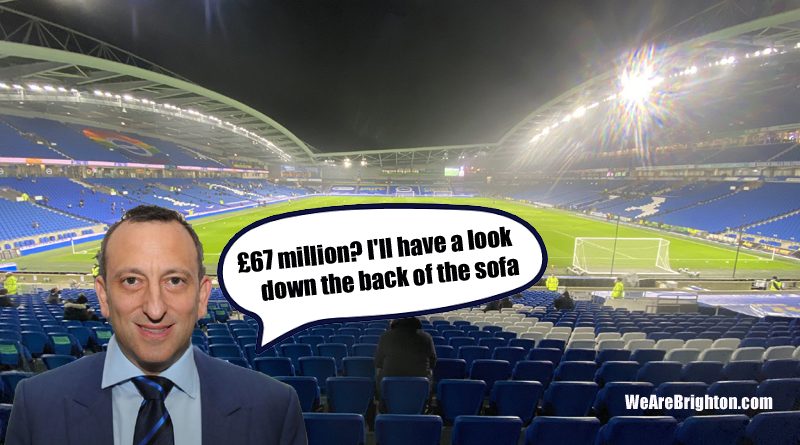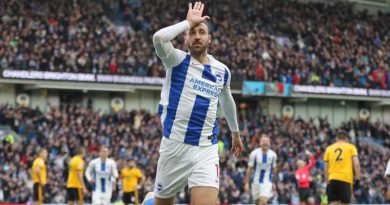Brighton & Hove Albion accounts show a £67m loss for 2019-20 season
The latest set of accounts from Brighton & Hove Albion are in and they do not make for pretty reading as the club recorded a £67 million loss in the 2019-20 season.
Around £28 million of that could be attributed to the carnage inflicted by Covid-19. Had the pandemic not taken place, then the club would have still been on to make a significant loss of nearly £40 million compared to £21.2 million in 2018-19.
Far from the Premier League being the land of milk and honey, Brighton actually seem to be losing more with each passing season spent in the top flight. 2019-20’s £67 million represents the biggest loss ever recorded in the club’s history.
The figure exceeds the £38.9 million lost in the Albion’s final season as a Championship club when they had none of the benefits of being in the richest league in the world. Only 2017-18 has seen Brighton finish in the black, recording a profit of £11.3 million for their first Premier League campaign.
Here is what we learnt from Brighton & Hove Albion’s 2019-20 accounts.
Covid-19 cost Brighton & Hove Albion more than £25 million
There were several reasons as to why Covid-19 hit football hard. Matchday revenue was obviously down as Brighton played their final five home games of the 2019-20 against Arsenal, Manchester United, Liverpool, Manchester City and Newcastle United behind closed doors.
In 2018-19, Brighton made £18.5 million from games at the Amex. That fell to £13.5 million, a drop of £5 million which means that the average home match is worth £1 million to the club.
With no prospect of a full stadium at any point during the 2020-21 season, the Albion can expect to lose out on around £19 million in the current campaign.
Crowds were also slightly down by 0.2 percent. That can be attributed to Brighton being unfortunate that four of their home games against the big six took place post-lockdown.
Matches with Liverpool, United, City and Arsenal would have been the best attended and therefore earned the most money because of the draw of the opposition.
The other Covid-19 related losses came from a drop in broadcast revenue. Because the final six games of the season took place after June 30th, they do not show up in the accounts. The Albion’s share of the television pie therefore dropped £23.6 million from £113.5 million in 2018-19 to £89.9 million in 2019-20.
Revenue from those missing six matches will however show up in the 2020-21 Brighton & Hove Albion accounts, where the Albion will report broadcast money from all games played since June 30th 2020 – the 38 of the current campaign plus the six of the previous one.
In a further hit to clubs, what Sky Sports, BT Sport and the other broadcasters pay is expected to be slightly less over the next three seasons due to a £330 million rebate owed by the Premier League for the season not being completed by the end of June. Television companies will collect their pound of flesh through paying less than their initially agreed contracts.
Brighton spent £55.6 million on players in the 2019-20 season
One of the most interesting aspects of Brighton & Hove Albion’s accounts is always discovering how much the club have actually spent on players after every signing is declared as undisclosed.
You know how these things work; the club complete a transfer but no fee is given, the national media report a figure, Brighton tell Andy Naylor and The Argus to parrot the line that the amount paid “is significantly less than being reported.”
The figures bandied about for the Albion’s new acquisitions over the course of the 2019-20 season were £20 million for Neal Maupay, £18 million for Adam Webster, £4 million for Aaron Mooy, £4 million for Tariq Lamptey and £2.5 million for Taylor Richards, which totals around £48.5 million.
Include another £7 million or so for further development squad additions and you reach that £55.6 million, suggesting that the figures we get told about are roughly accurate despite what Brighton may try and claim.
The eagle-eyed among you will have spotted that neither Leandro Trossard or Matt Clarke are included. Their deals were completed prior to June 30th 2019 and show on the 2018-19 accounts, when Brighton spent £80.9 million on signings, rather than 2019-20.
In total, the Albion have forked out £191 million on players since joining the Premier League, a total which has not been offset by any major sales until Anthony Knockaert moved to Fulham for around £15 million in the summer (which again will show in the 2020-21 accounts).
Food for thought for those who think the club should happily chuck £30 million at an unproven striker – and an understandable explanation as to why Tony Bloom has been reluctant to open his cheque book much this season.
Future player sales could easily help to remedy the losses the club have made. Brighton have a lot of talent in their squad wanted by a lot of big clubs.
If Yves Bissouma goes for £60 million this summer and Tariq Lamptey for £50 million, suddenly there is an additional £110 million on the balance sheet and a £67 million loss can be turned into £43 million profit. It is why we should perhaps steady ourselves for some high-profile departures over the next year if acceptable bids do come in.
Brighton’s wage bill is in excess of £100 million
Brighton’s wage bill stood at £103.2 million in 2019-20 with the average weekly pay packet £47,951. That is the seventh lowest in the Premier League, so in terms of finishing position based on wages, the Albion’s 15th place under Graham Potter was almost exactly where you would expect them to be.
The wage bill did not differ too much at all from the 2018-19’s £101.6 million in 2018-19. Potter shifted some high earners when loaning out Knockaert, Florin Andone and Jurgen Locadia which meant that the new acquisitions did not push player pay even higher.
IKEA is great for flat pack furniture, meatballs and £10 million
Commercial revenue represented some good news for Brighton as it grew to a record £29.5 million, up £18.1 million on what came in during the 2018-19 season.
Some of that rise comes from new deals with both American Express and Nike. Amex signed up to a new 10 year sponsorship agreement worth £100 million in August 2019 and three months earlier Nike renewed their partnership with the Albion on improved terms.
Over half of the increase in commercial revenue came from the building work going on at the training ground. New homes and most excitingly of all, Sussex’s first IKEA are being constructed as part of a development which netted the Albion a cool £10 million in 2019-20.
As if the prospect of being able to go to Lancing in the very near future to buy a television stand, a ceramic elephant, a thing which holds your iron on the wall and a big box of meatballs was not exciting enough, we now know that the Swedish furniture giants arrival is contributing significantly to Brighton’s finances.
Paul Barber is very well paid
The 2019-20 season accounts reveal that the highest paid club official at Brighton – Paul Barber – took home a shade over £2 million, which included a loyalty bonus.
It must have been an extremely difficult season to be at the helm of a Premier League football club with all the problems that the pandemic has caused.
Barber though has been superb throughout the crisis. The club got their season ticket refund scheme spot on, they have supported the local community with the Amex being used as a Covid-19 testing site and a vaccine training centre, and the launch of the Albion As One Fund to support Sussex charities who suddenly found their fundraising efforts halted provided a much-needed boost to local organisations.
Brighton led from the front too when it came to getting the Premier League season restarted. He was the most open and honest of CEOs, never shying from explaining the club’s position even if it was likely to result in a backlash from other football supporters – most notably when half of top flight fans wished immediate relegation on the Albion because of the club’s opposition to neutral venues.
There have been a few questionable moments. Nobody knows what came of the bizarre attempts to trademark the word 2,600-year-old word ‘Albion’ and Barber did not cover himself in glory with his reaction to the backlash surrounding the ill-fated £15 Premier League PPV scheme, saying, “Unfortunately, fans will always want everything for free. But we are a business.”
Not the best choice of words to supporters who throughout the 1990s and 2000s gave money from their own pockets to help their club survive. Without the generosity of fans, Brighton would have gone out of business and there would be no business to pay Barber so handsomely for his services.
Those moments can be overlooked as he has largely been excellent in 2019-20 though, always willing to engage with fans and reply to an email even if it is 11pm on a Friday night. The Albion are lucky to have him.
Thank God for Tony Bloom
Each season when Brighton release their accounts it serves as a reminder of the astonishing financial commitment that Tony Bloom has made to the Albion and 2019-20 is no different.
Bloom lent another £32 million to Brighton & Hove Albion during the course of last season, taking his total investment in the club since becoming chairman in 2009 to £394 million. £90 million of that is in the form of shares with £304 million in loans which will not have to be repaid in full (we hope!).
Whilst losses of £67 million are a massive concern, Bloom’s presence means that they are not as troubling as they might otherwise be. When other Premier League clubs report their financial results for 2019-20, they too will show massive losses because of the pandemic.
Brighton being owned by a fan like Bloom, who is willing to invest so much of his own cash out of love for the club leaves us in a better position than others, who do not have a genuine supporter at the helm and who may now be balking at the level of investment football needs to survive the pandemic.
Thank God for Tony Bloom.
You can read a more much thorough analysis of Brighton’s 2019-20 accounts over on the excellent Price of Football website.




